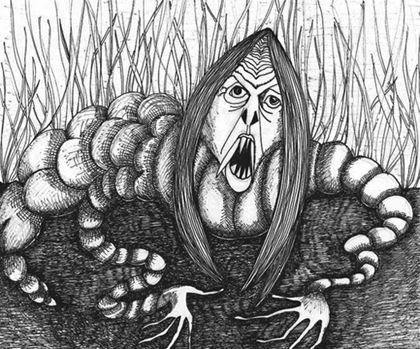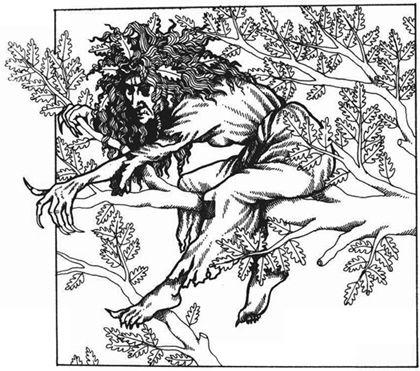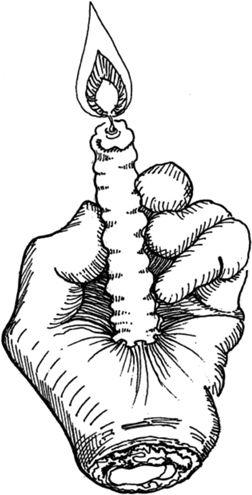The Sorcerer's Companion: A Guide to the Magical World of Harry Potter (36 page)
Read The Sorcerer's Companion: A Guide to the Magical World of Harry Potter Online
Authors: Allan Zola Kronzek,Elizabeth Kronzek

As genuine as grindylows may be in the wizarding world, no child over the age of ten in Yorkshire, the only region of England where grindylows are part of local folklore, would admit to believing in the nasty creatures. That’s because grindylows fall into a special category of supernatural beings known as “nursery bogies.” Never really taken seriously by adults, nursery bogies have been invented to scare children away from dangerous or forbidden activities.
Don’t go too close to the water, or the grindylow will pull you under and have you for supper!

Because the grindylow is part of oral, rather than written, tradition, its physical characteristics are hard to pin down. However, if the grindylow looks anything like the water spirits Jenny Greenteeth and Peg Powler—its counterparts in other parts of England—then it has the face of a
hag
, with long green hair, green skin, pointy green fangs, and a gaping mouth. Perhaps it’s Harry’s advanced age that allows him to realize that despite such gruesome features, all it really takes to get rid of one of these pests is a swift kick in the head.


 he British Isles are said to be populated by a great variety of hags. Some are benevolent spirits associated with harvests and spinning, others are witchlike figures who torment and even eat people. One is an ancient nature spirit, responsible for changing the weather and fashioning the natural landscape. But all of them have a few things in common—they are women, they are old, and they are hideous.
he British Isles are said to be populated by a great variety of hags. Some are benevolent spirits associated with harvests and spinning, others are witchlike figures who torment and even eat people. One is an ancient nature spirit, responsible for changing the weather and fashioning the natural landscape. But all of them have a few things in common—they are women, they are old, and they are hideous.
Hanging out with hags like those who frequent the Leaky Cauldron can be a dangerous business, since most have malice on their minds. They enjoy sitting on sleeping humans, causing nightmares and depriving their victims of breath. Someone who is “hag ridden” in this manner will awaken exhausted—if he is lucky enough to wake up at all. A flour sifter placed under the head prevents hag riding, since the hag is forced to pass through each hole in it, a feat that will take her all night.
The most famous hag in England is Black Annis, a one-eyed cannibal with blue skin, long white teeth, and claws of iron. She is said to dwell in the hills of Leicestershire, in a cave she carved from the rocky terrain with her own fingernails. In front of her cave stands a great old oak tree, in which she sits to survey the countryside in search of prey. When a tasty-looking child comes into sight, she swoops down and has a feast. When not in her tree, Black Annis is often seen sitting at the mouth of her cave, perched atop a pile of her victim’s bones.

Black Annis in her tree
. (
photo credit 36.1
)
A Scotsman is more likely to recognize the Storm Hag, an ancient Celtic goddess also known as the Cailleach Bheare. Like Black Annis, the Storm Hag has a blue face and only one eye. She is distinguished by her white hair, which resembles dry, gnarled branches, and by the gray plaid dress she always wears. Closely associated with winter, she is said to usher in the season by washing her clothes in the Corrievreckan (literally “the speckled
cauldron”
), a great whirlpool off Scotland’s western coast that can be extremely hazardous for ships. She also carries a
magic wand
or staff, with which she strikes the grass and crops, covering them with frost each year after Halloween. Legend holds that the Storm Hag created the islands of the Inner Hebrides by dropping rocks and peat into the sea. Many Scottish lakes and mountains are also attributed to her artistry.


 typical young wizard on a shopping trip with Dad might beg for a new racing broom or a self-stirring cauldron. But Draco Malfoy wants a Hand of Glory—a grisly magical candleholder made from the severed hand of a hanged man. Lucius Malfoy scoffs at his son’s interest, but years later Draco will get his Hand of Glory and use it to guide dark wizards through the halls of Hogwarts.
typical young wizard on a shopping trip with Dad might beg for a new racing broom or a self-stirring cauldron. But Draco Malfoy wants a Hand of Glory—a grisly magical candleholder made from the severed hand of a hanged man. Lucius Malfoy scoffs at his son’s interest, but years later Draco will get his Hand of Glory and use it to guide dark wizards through the halls of Hogwarts.
For Draco, the Hand of Glory casts a light that only he can see, allowing him to move undetected under cover of darkness. In British folklore dating back to the early 1700s, the Hand of Glory was known mainly as an aid to thieves—preventing sleeping people from waking, so that an intruder could plunder with ease. One collection of folklore summarized the Hand’s power in verse:
Wherever that terrible light shall burn,
Vainly the sleeper may toss and turn;
His leaden eyes shall he ne’r unclose
So long as that magical taper glows,
Life and treasure shall he command
Who knoweth the charm of the glorious Hand.

In a widely circulated story, a thief disguised as a weary traveler appears at a country inn on a stormy night. He waits until everyone is asleep (or so he thinks) and then lights his Hand of Glory, confident that all will slumber while he steals their valuables. But a clever maid suspects he’s up to no good and secretly stays awake. While he gathers his treasure, she foils his plans by dousing the Hand of Glory with milk. The household is immediately aroused, and the thief is forced to flee.
Similar tales exist in German folklore, which tell of thieves lighting their way with the fingers of an unborn child stolen at midnight from the womb of a hanged woman. These “thieves lights,” like Draco’s Hand of Glory, shine for their owner alone. They will burn whenever he needs them, can be extinguished at his mere thought, and allow him to remain invisible yet see everything around him.